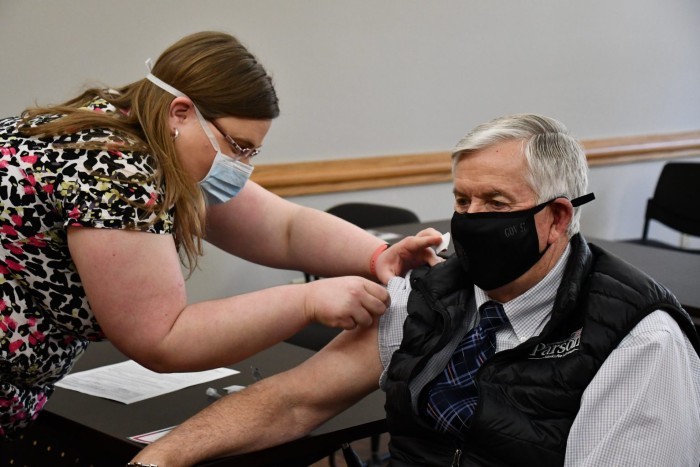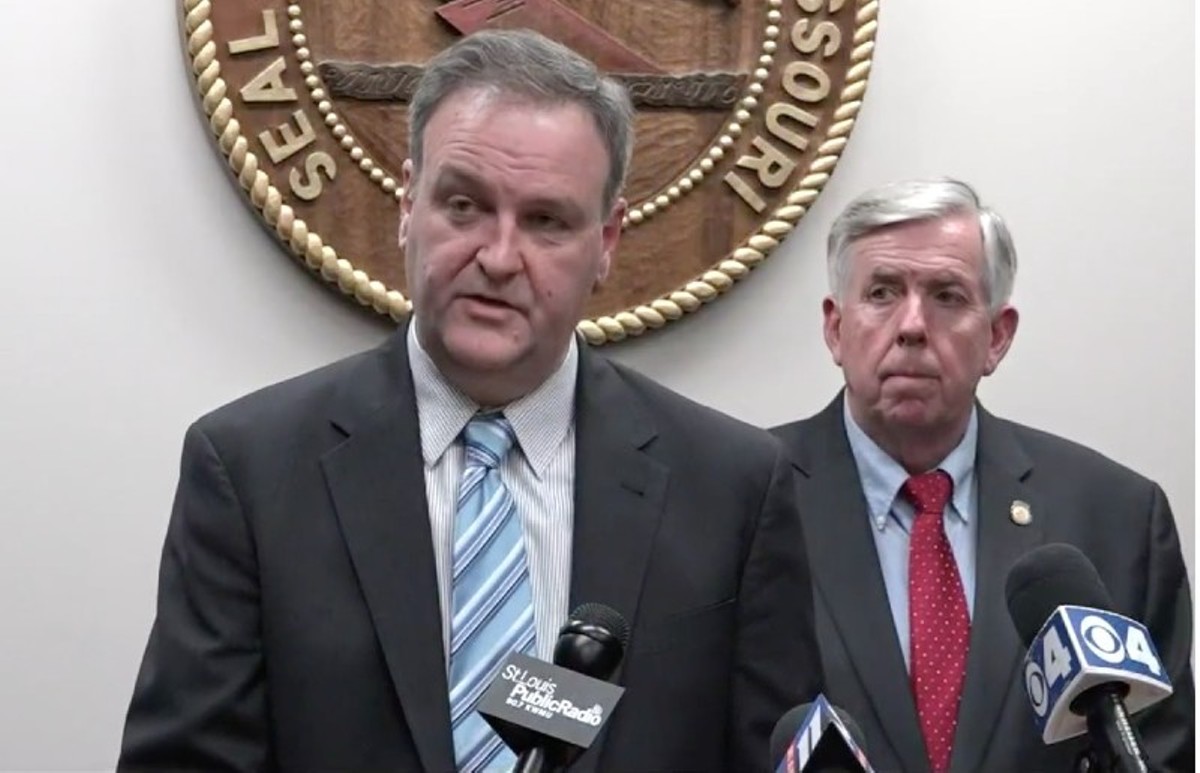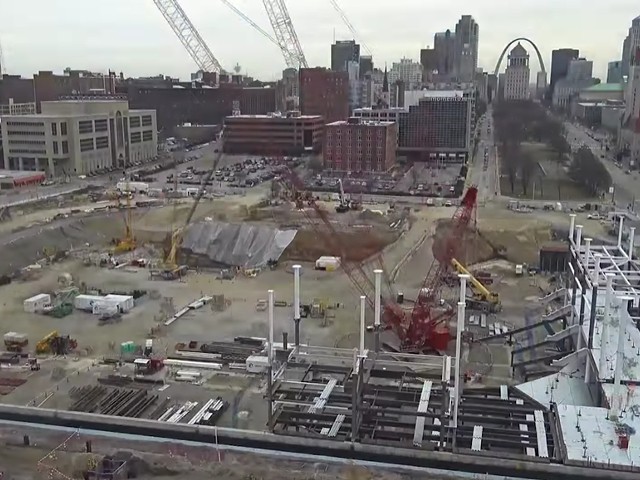This story was originally published by the Missouri Independent.
The Hickory County Health Department reported 853 total local COVID-19 cases in its weekly update Friday, five more than a week earlier.
But residents of the southwest Missouri county who check the Department of Health and Senior Services dashboard for information would not have known that. Instead, they would see a cumulative 467 cases. Those that watch it closely would think only one case had been reported since Feb. 19.
Deaths are also a source of disagreement between the local and state reports. The county report shows 35 deaths, while the state dashboard reports 13.
The difference is something Administrator Dawn Vader has been dealing with for months. Her agency has done contact tracing on all 853 cases. She knows the count is accurate.
“We look at what is sent to us from clinics and when they confirm a case, show they have a positive confirmation, we add them to our list and we contact them and interview them and do our investigation,” she said.
It is a story repeated in counties across the state. Local health officials said explaining why their reports don’t match the state figures creates extra work and makes the public distrustful.
And it means that as Missouri marks one full year since the first case was reported in St. Louis County, there is no true accounting of the toll, both in sickness and death, of the past 365 days.
“That is an unknowable question,” said Chris Prener, an assistant professor of sociology at St. Louis University.
Prener has been compiling data on the pandemic in Missouri, including cases and deaths, almost from its beginning. He uses social media and a weekly newsletter to publish his data in maps and graphs to show the course of the virus’ spread.
“Our testing, especially in the first four months, was not nearly widespread enough,” Prener said. “In some respects, no matter what the state releases today or in the future, we will never know how many cases there were.”
Of 117 local health departments in the state, 111 post regular COVID-19 data reports online. A review of that data by The Missouri Independent on Tuesday showed only two matched the state report on cases and 10 matched on deaths.
Overall, those health departments, which serve 98 percent of the state’s population, reported 78,122 more cases and 1,116 more deaths than the state health department dashboard.
The discrepancy lies in what is included in local reports that doesn’t appear in the state data. Most local reports include “probable” cases identified by the increasingly common antigen, or rapid, test.
The Department of Health and Senior Services has never reported total cases identified by the antigen tests, instead only presenting cases “confirmed” as a result of what is called PCR testing.
Even within the state health department, there’s been debate for months over whether it should also publicly report probable cases. The Centers for Disease Control directed states to include probable cases in their official reports in April 2020.
“It is a thing that has been discussed and talked about since May and June on a regular basis,” the department’s epidemiologist Nathan Koffarnus told The Independent on Friday.
Over the seven days ending March 2, antigen tests identified 1,623 probable cases while PCR tests identified 2,270 confirmed cases.
In many rural communities, the only test available is an antigen test.
“The biggest benefit is going to be for those rural counties,” Koffarnus said.
Buchanan County’s report shows 10,078 cases, 45 percent more than the state data, and 172 deaths, 25 percent more than the state.
“We have been looking into this for several months because we keep getting that question,” said Debra Bradley, administrator of the St. Joseph Health Department.
The state is trying to make state and local reports match more closely by adding data on coronavirus infections identified with antigen tests.
When the update is finished, it will increase the state’s total cases by about 80,000, Koffarnus said Friday.
The update was planned for Friday, but issues with the system meant a delay, with expectations it will launch early in the coming week.
Death report differences
The state data on deaths will probably continue to be lower than the totals from county reports, Koffarnus said. Death certificates are typically received three weeks or more after a death and processed weekly.
On Wednesday, the latest batch added 225 deaths to the state report, including two from October and 153 from January.
There are also daily additions to the report on COVID-19 fatalities from entries made by local health departments of their death reports.
“As soon as in the system it gets counted,” Koffarnus said. “It has put such a strain on the public health system and the state, with the volume of cases, deaths and other things coming in it is not always at the top of everyone’s priority list to go in and enter death in a case already investigated when there are other cases to work on.”
Prener said he’s not sure when, or if, the state deaths report will match local figures.
One hypothesis is that the state’s data will eventually catch up with those local numbers but it is going to take weeks or even months after we stop having people die of COVID in Missouri for that to happen,” Prener said.
‘Like a roller coaster’When Gov. Mike Parson joined St. Louis County Executive Sam Page on March 7, 2020, for a news conference announcing the first state’s first case of the new disease called COVID-19, there were 279 cases total in the United States.
When the first death was reported in Boone County on March 18, 2020, there were eight cases statewide and 6,500 nationally.
By the end of the month, the state was reporting 1,327 cases, with at least one case in 67 of the 117 local health jurisdictions. Each of the 114 counties and the city of St. Louis has a health department, as do Joplin and Kansas City, which cross county lines.
“It has been like a roller coaster,” Bradley said. “We start out and we hear of this new virus and it is over in China, and we are trying to anticipate what it is going to look like when it arrives. We have the anticipation, the buildup, first case at the end of March.
“We think, ‘OK, we can handle this.’”
At the end of April, Buchanan County had 87 cases, enough for a per capita rate higher than many but one-third that of St. Louis and St. Louis County. Then came an outbreak at the Triumph Foods packing plant, where mass testing identified 412 positive cases by early May.
The county’s per capita infection rate increased 695 percent in May.
“A lot of places may have had similar infection rates, but they didn’t test for it at that time,” Bradley said. “That was a very steep learning curve as far as ‘what is contact tracing,’ what did it involve and how do we protect our community.”
On July 8, the Department of Health and Senior Services reported 575 new COVID-19 infections, pushing the statewide total above 25,000. One was in Hickory County. It was the last local health jurisdiction with a confirmed case of the contagion.
When it would arrive, and how hard it would hit the county of 9,500 where one-third of the population is over 65, had been a source of anxiety through the spring and early summer for health administrator Vader.
It came in with the people taking vacations at Pomme de Terre Lake and chancing a visit with family, Vader said in a recent interview.
“There were certain gatherings, mass events, that is why we got it around the Fourth of July,” she said. “A lot of people came to the lake, came from other states, and brought it with them.”
By the end of the month Hickory County had 16 cases, which increased to 64 by the end of August.
As the pandemic accelerated, it became clear that in-depth case investigations were impossible, Vader said.
Many counties gave up contact tracing altogether.
“We would not get a lot of cooperation,” she said. “We would just say you need to let them know that if they were around you during this time, still contagious, give us a call and we’ll do a test.”
By the end of July, Missouri was averaging 1,500 cases per day, four times the rate at the beginning of the month. The state report surpassed 50,000 total cases on July 31.
During August, the return of almost 30,000 students to the University of Missouri in Columbia brought a surge of COVID-19 to Boone County that disrupted public school plans for in-class instruction. By the second week of September, there were more than 600 active cases among students.
Boone County averaged less than a case a day in April and fewer than two a day in May. That became 46 a day in August and 71 a day in September.
“Things didn’t end up as bad here as we initially thought they could be,” said Scott Clardy, assistant director of the Columbia-Boone County Department of Public Health and Human Services. “Then things started morphing to the point where we were seeing more and more cases due to contact with a known case. More and more community transmission was a sign it was circulating in the community.”
The state reached 100,000 cases in the second week of September, and during that month recorded more than 500,000 PCR tests and about 25,000 antigen tests.
Early positive results from antigen tests often led to PCR tests, Koffarnus said. That is one reason the numbers on state reports agreed closely with local reports at that time, he said.
“There are a significant number of people in the counts as PCR cases that are in both,” he said. “For months there it really wasn’t as pressing an issue as it is now.”
There was only one day in October when fewer than 1,000 new cases were reported and total cases surpassed 200,000 during the first week of November. There was no day in November with less than 2,000 cases and the total reached 300,000 on the first day of December.
The third week of November was the state’s biggest week of testing of all kinds, with more than 206,000 tests. It was the peak week of cases confirmed by PCR tests, with 31,590 total cases reported, an average of 4,512 per day.
There were 33,000 antigen tests that week, about 15 percent of the total. Expanding availability and lower cost meant it was the only kind of test available in many locations.
Beyond case counts
Omitting the results of antigen tests didn’t just alter the topline report of cases.
At that time, the state calculated a positive rate on tests only for PCR tests. For many rural counties, the positive rate soared as use of the antigen test spread.
In September and October, PCR testing identified 28 new cases in Knox County. If the county positive rate had reflected antigen testing, health administrator Lori Moots-Clair said, it could have relaxed rules on visits to nursing homes.
“When we were at a low spot and doing all antigen testing, it would have dropped our local positive rate and they could have potentially changed the way they were doing some things,” she said.
When cases surged in November, the antigen tests helped identify cases in nursing homes and schools and identify sources of community transmission, Moots-Clair said.
“There are just a lot of ways those tests can be used and they are very effective,” she said.
The state report shows Knox County, in northeast Missouri with about 4,000 residents, has had 179 COVID-19 cases while the local report shows 393.
“We had a real problem in January, at the end of December,” Moots-Clair said. “We were reporting a public health alert, with cases as high as it has been in this community. But the state report showed less than 10. We had to really do some education with our people.”
The state report showed more than 400,000 cases for the first time on Jan. 3 and that was about the time the difference between state and local case counts became more pronounced.
While the state report showed 13,600 cases in Boone County that day, the local report showed 14,100. On Friday, the difference had grown to 1,576 cases.
The daily count on both state and local reports, however, was slowing. Clardy said his agency began telling people to ignore the state report.
“We haven’t looked at that in quite some time,” he said. “We felt like our data was the most current data. When people would ask about those differences, we would say ‘stick with local data.’ We update that daily and we believe it is the most current.”
That message wasn’t always well received, said Linn County Health Department Administrator Krista Neblock.
“We’ve had people say we are trying to inflate our numbers to make them worse,” she said.
The number of PCR tests fell below 100,000 a week in January while the number of antigen tests reached about 55,000 a week. The official daily state case count declined, with fewer than 1,000 cases for the first time since October on Jan. 25 and fewer than 500 for the first time since August on Feb. 8.
Like the early days of the pandemic, the large numbers of new confirmed cases in recent weeks have been in the state’s urban centers, where PCR testing is easily available.
Testing declined further in February, but confirmed case numbers have fallen faster. The daily average of reported cases fell to 350 per day last week, about the same as in mid-June 2020. It would have been about 230 per day higher if antigen test results were also reported.
The second year
As the pandemic’s Missouri anniversary arrives, just under 10 percent of the state’s population has had a case of COVID-19 identified with PCR or antigen testing. Another 16 percent has had at least one shot of vaccine.
While Bradley said the pandemic has been like a roller coaster, Prener said a better analogy is a forest fire.
With vaccines available, and more than 25 percent of the state with some level of immunity, it is now more like a controlled burn than the raging inferno of October and November.
“That gets at the essential nature of what the next year will be like,” he said. “We aren’t going to put the fire out in the next three months, we are not going to put the fire out in the next six months, we will not put out the fire in the next year.”
It is unknown what level of resistance will bring true “herd immunity” that will end the pandemic, Koffarnus said. Personally, he thinks it is already showing in the lower case numbers, regardless of which test is used.
“It is a combination of natural immunity from people that have been infected and vaccination that is having an effect,” he said. “What we really need to think about is we have pockets of herd immunity.”
The number of cases began multiplying rapidly last year as warm weather arrived. Bradley worries about a repeat if people relax precautions before vaccines are generally available.
“They leave their mask at home, they leave their worries at home and it does create anxiety,” she said. “We are just learning about these variants that are in our nation and trying to determine exactly where they are in our state.
“I don’t want my people getting sick,” she said. “I don’t want my people dying. We have had enough of that.”






